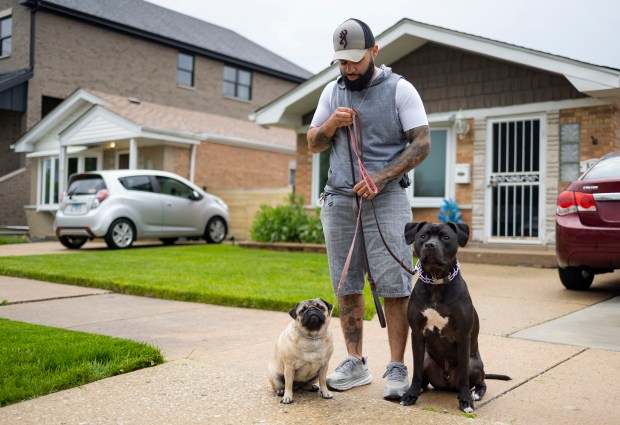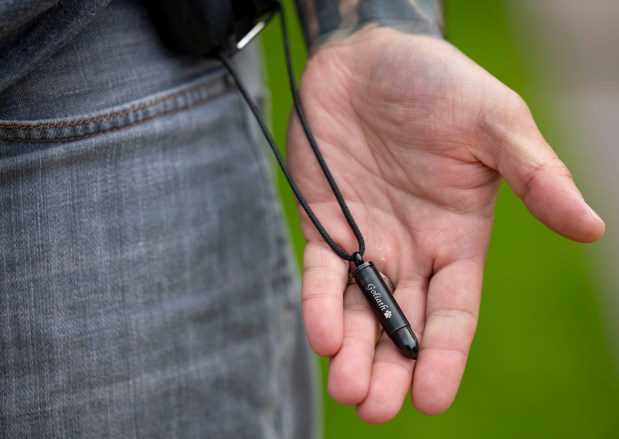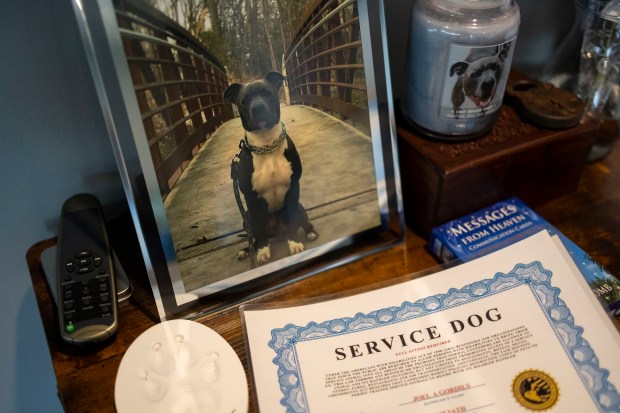Joel Gordils said he was a step away from killing himself when he heard the click of his dog’s toenails on the floor.
It had been several months since Gordils left his job as a Chicago police officer and the realities of his new disabilities — the result of being dragged by a car during a traffic stop in November 2020 — had begun to set in.
On that day in February 2021, Gordils, 34, said he felt so alone that he’d pulled out his gun with the intent of shooting himself just as his pit bull Goliath walked into the room. He said he put down the gun, held onto Goliath and cried.
Gordils got Goliath, whom he credits with saving his life, certified as a service dog later that year. Mental health experts and law enforcement officials looking to help officers cope with on-the-job trauma see therapy animals as a promising way to support the well-being of cops who have historically rarely discussed their mental health needs.
Authorities have sounded the alarm on the importance of officer wellness for years, even making it part of the federal consent decree meant to reform the Chicago Police Department. Last Thursday, an off-duty Chicago police officer was found dead with an apparent self-inflicted gunshot wound in his Near West Side home. He joined a grim tally of at least 73 emergency workers and first responders from around Illinois who have died by suicide since 2018, according to the nonprofit organization First Help.
Recently published research also suggests that an officer’s mental health may be linked to their risk of on-duty misconduct.
The Illinois Law Enforcement Training and Standards Board, which manages professional development and quality control for police departments across the state, recently acquired its first therapy dog.
Board Chair Sean Smoot said he’d witnessed how animal therapy helped officers in other big-city departments such as Baltimore after they’d responded to traumatic incidents and hopes the board’s program will have a similar impact.
“A therapy dog really helped the officers decompress, open up in after-action gatherings and talk about what happened and really work their way through the trauma exposure,” he said.
Gordils, the former police officer, said therapy dogs were good for just about anyone.
“It really doesn’t matter what kind of issues you have,” he said. “Dogs help. You have a roller coaster of a day, the dog grounds you.”
Trooper
On a recent May morning, a Bedford Park police officer sat cross-legged on the floor of the Cicero Community Center, scratching a black border collie under the chin.
Cops from 33 departments around the state circled the building in small groups, practicing their crisis response techniques. The officer on the floor had just completed three simulations, workshopping how he and his colleagues could best respond to a suicide attempt, a woman with dementia and a person suffering from extreme paranoia.
The border collie, Trooper, accepted the attention in silence. He stood up to eye a piece of pizza from a nearby table, nosed the officer and sat back down to get scratched behind the ears.
Trooper is the first recruit for the Illinois Law Enforcement Training and Standards Board therapy dog program, started in honor of the board’s long-serving labor representative, Teresa Smoot.
Teresa Smoot, who died of liver failure in February, was inseparable from her Goldendoodle, Ramsey, according to her ex-husband and board chair Sean Smoot. Teresa was an enthusiastic backer of therapy dog programs, partly informed by her history with trauma exposure in her personal life and as a 911 operator, Sean said. She even started Ramsey in training to be a therapy dog, but the pandemic interrupted that process.
Sean Smoot said the program got its approval in the last days of Teresa Smoot’s life. He was visiting her in the hospital when he got a call confirming the board could sponsor its first therapy dog in her honor.
Five months before Smoot’s death, Trooper had been found tied to a tree and brought into an animal shelter, then to training through the Cook County sheriff Tails of Redemption program, where people in custody train and interact with shelter dogs.
Officer Jerry Roman said that program staff flagged Trooper quickly as a potential service dog who was even-keeled and didn’t mind distractions or being handled.
“He wasn’t crazy about treats, but he loved having a chance to snuggle up with you,” Roman said. “He just wanted to be around the humans and interact and take in all the affection you have to give.”

Trooper started work about six months after he was found. ILETSB Deputy Director Jennifer Wooldridge saw that even a brief interaction between Trooper and an officer made an impact.
“He would go up and sit next to someone and just put his paw in her lap and she’s like, ‘Oh my god, you have no idea how much I needed this,’” Wooldridge said.
‘Hurt people hurt people’
Sean Smoot said when he started his law enforcement career, nobody wanted to talk about mental health needs among first responders.
But he’s watched that reluctance begin to ebb away over time. To explain why the shift was important beyond the well-being of individual officers, Smoot quoted testimony he heard while working on the 2015 White House Report on 21st Century Policing: “Hurt people hurt people.”
Carrie Steiner, a psychologist who works with Chicago police officers, said it shouldn’t be surprising that officers can react badly to instances of violence or abuse they witness on the job. She said the average person sees about five “critical incidents,” or situations where their or another person’s life is in danger, over the course of their lives.
The average police officer in a medium-sized department sees about 188 critical incidents over the course of a 20-year career, she said. In a large department such as Chicago, that number is even higher. She said officers just out of a critical incident have a roughly 1 in 3 chance of developing post-traumatic stress disorder.
“It’s self-preservation,” she said. “You’re in combat, you don’t want to be thinking that everybody’s coming to hug you. You think everybody’s coming to hurt you. But that’s not so good for their overall mental health or when they go home to be with their families.”
When Steiner talks with officers who are skeptical of talking about mental health care, she asks them to think about it as a safety issue and part of working well as a team.
“You can have all the tactics in the world on how to do something, but if your head isn’t in the game, it doesn’t matter,” she said.

She asks them to think about whether they’d prefer to work with someone who is learning to cope with depression or stress through therapy — “or would you rather work with an officer who is putting a gun to his head and debating killing himself?”
Short of preventing suicides, recently published research also suggests that helping officers confront their traumatic experiences and built-up mental health issues could bring significant potential public benefits — and that trouble on the job may correlate to other off-duty issues, or vice versa.
His job was ‘Joel, are you OK?’

Gordils, the former police officer, said he saw plenty of nightmare material in his time with CPD. But he didn’t talk about it all that much.
“The law enforcement idea is you’re tough, you brush it off,” he said. “You have thick skin.”
In November 2020, Gordils and his partner attempted to stop a car when the person they were trying to pull over put the car in reverse with Gordils holding onto the side of the window. Gordils was dragged for about a block before being thrown from the the car onto the sidewalk.
He sustained multiple fractures to his skull, jaw and back and several tears to his right shoulder, among other injuries, he said.
The next thing Gordils said he remembered was waking up in his mother’s living room with Goliath, his pit bull, next to him. He’d gotten Goliath in 2017, intending to train him as a diabetic support dog and to make a point that pit bulls don’t deserve their reputation for aggression.
After his injuries, Gordils got Goliath trained and certified as a service animal. Besides his Catholic faith, the dog was his main anchor as he struggled through the first months of recovery.
Besides the headaches and ringing ears and issues with his short-term memory that ultimately forced him to turn in his badge, Gordils said his emotions began swinging to extremes in the aftermath of his injuries. He’d see a car roll through a stop sign and “go to a level 10,” he said.
The sight of a woman with a stroller was enough to reduce him to tears.

He said he wakes up every morning and for the first three seconds he was conscious, he would feel as though he had just been dragged. Goliath, he said, kept him from dipping too far into his memories.
“If it wasn’t just a headache day, if it was an ‘I am in tears when I wake up and I’m in tears when I go to bed’ type of day, the way he was velcroed to me was amazing,” he said.
These days, Gordils said he sees a therapist along with other doctors as he continues to manage his injuries. He said he also works with dogs at a dog training facility in southwest suburban Frankfort and spends time with his two house dogs, David and Frida. He encourages officers he’s still in touch with to talk about what they see on the job. He encourages them to take their days off.
Waking up is still difficult: He said he still sometimes hears the tires screeching for the first few moments of each morning. Or he can see the block where he was hurt in his head.
Goliath died of cancer in February. Gordils carries the dog’s ashes in a tiny vial that hangs from his belt loop.
He said he anticipates getting another dog when he’s ready, although he isn’t convinced any other animal could measure up.
“I had no idea the impact (Goliath) would have on my life,” he said. “His job was, ‘Joel, are you OK?”’




